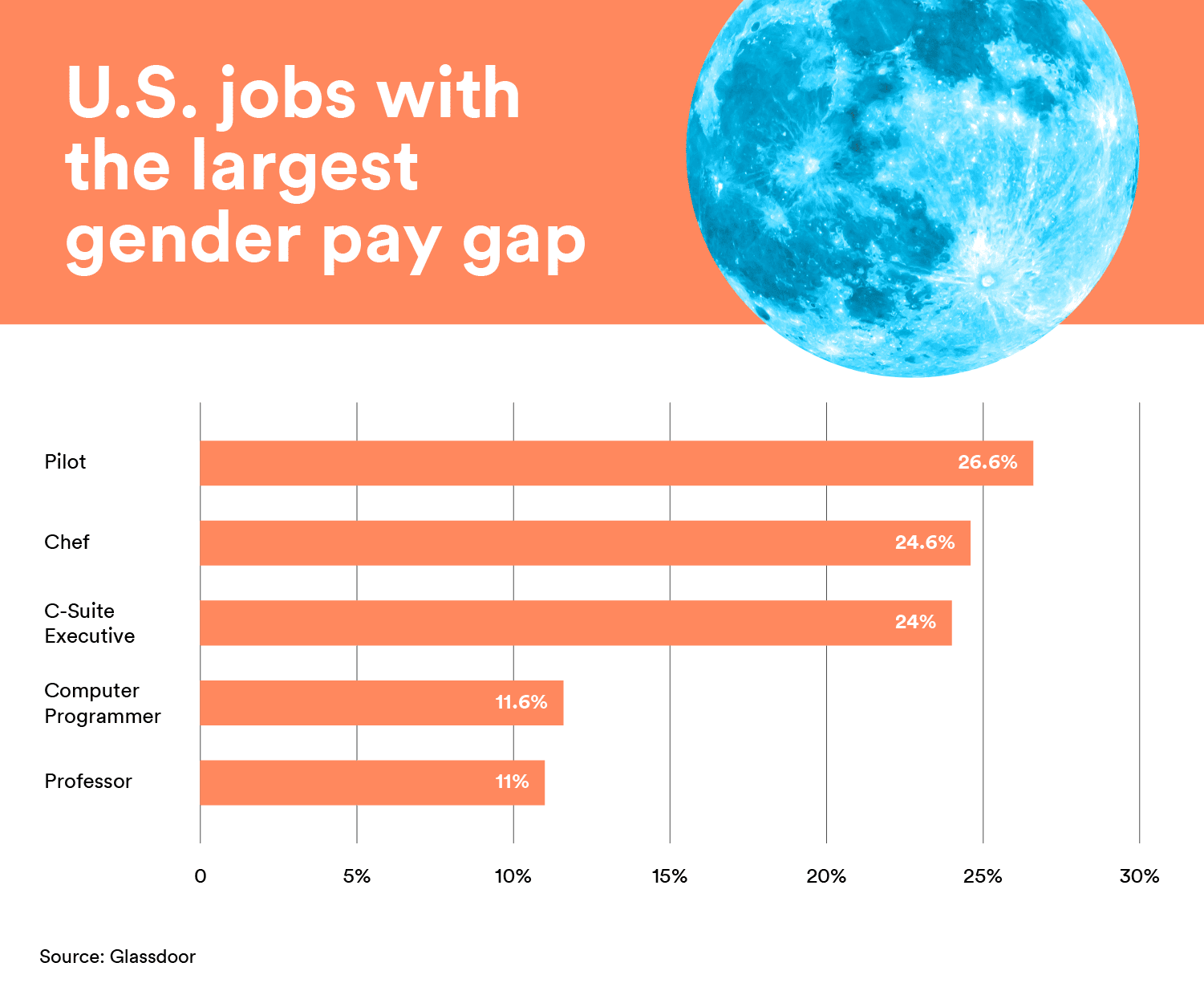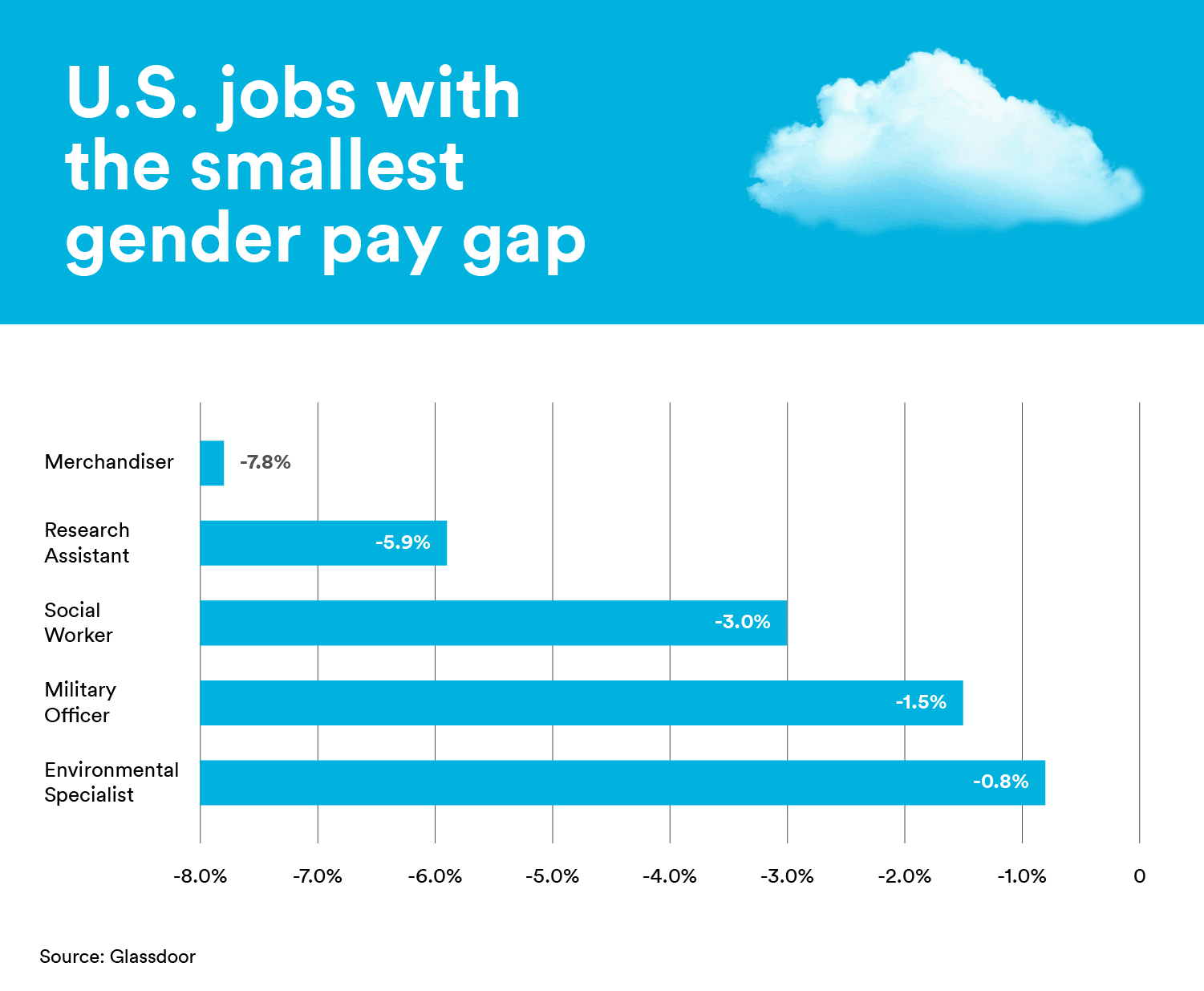If you’re a working woman, you’ve most likely encountered pay inequity at some point in your life. This year, Glassdoor released a report that analyzed over 400,000 salaries reported by full-time workers in the U.S. They found that the current unadjusted pay gap (the overall pay difference between men and women) is 21.4%.
That means women earn an average of 79 cents for every dollar earned by men who are in the same position and have the same experience. This research uncovered a troubling reality: If current wage factors in the U.S. persist, complete pay equality won’t be accomplished until 2070.
This pay gap isn’t just present in the workforce. It’s something that has permeated several areas of our lives, including life insurance. But how do we fix it? Education around why the pay gap exists is a good start.
To help, we’ve outlined 10 jobs with the largest and smallest gender pay gap, why it exists and whether or not there’s hope for more equitable pay in the future.
Jobs with the largest gender pay gap

When looking at jobs with the largest gender pay gap, we found several similarities. Many of the professions listed are high-paying, male-dominated roles that sometimes have gender stereotypes that influence the behavior towards women.
Below are five jobs with the largest gender pay gap, insight into why men are being valued more and what action women can take.
1. Pilot

Male pilots were found to make 26.6% more on average than their female counterparts. This is the largest gender pay gap in 2019. Are you surprised?
Today, female pilots only make up 7% of all certified pilots and many women report experiencing some sort of harassment in the workplace. Airline pilot and certified flight instructor Sarina Houston says that “Many men falsely assume women don’t want to do it. They mentor boys instead.” It’s hard to get anywhere with this mentality hovering in the industry.
However, there is still hope. Organizations like Women in Aviation are working to provide mentoring paths for women and the number of female pilots continues to slowly, but steadily increase.
2. Chef

The culinary industry comes in second when discussing the current gender pay gap. Female chefs and head cooks make around 78 cents to the dollar men make. That means women get paid over $7,000 less per year with men making 24.6% more on average. Why? While combating workplace harassment is no surprise to female chefs, they also have to deal with being put in a box.
Head Chef at HelloFresh, Claudia Sidoti, tells Forbes that “Women, in particular, get associated with being pastry chefs, not executive chefs, and for them, it can be really hard to break that mold and transition.” Today, around 76% of chefs are male and around 23% are female.
While progress is being made, there’s still a lot of work to be done. Sidoti goes on to say that “Particularly in male-dominated kitchens and organizations, I’ve found that trusting my instincts and following my intuition has been a key ingredient to success.” Hopefully, with more women taking on this mindset, we will begin to see big moves in the culinary industry in the coming years.
3. C-Suite executive

Climbing the corporate ladder has been notoriously harder for women throughout history and like many other leadership roles, women CEOs and C-Suite executives are paid much less than men. In the case of the C-Suite, women are paid 24% less than their male counterparts.
According to the 2018 Women CEO report, 22% of replacement CEOs are women. This is up 18% from 2017. However, this uptick was in part due to the #MeToo movement. Eight CEOs were replaced last year because of sexual misconduct. Despite these positive numbers, according to a Pew Research Center analysis of S&P 500 companies, women held around 5-12% of corporate executive positions in the U.S. in 2017.
In order to demand an equal salary in the C-Suite, we need more women to take on leadership positions in the workplace. If you’re unsure where to start, Nicole Anasenes, CFO & COO of Squarespace, encourages women to communicate and ask for what they want. She says “the more communication you have with managers and mentors about what you want out of your career, the more empowered they are to support you in achieving your goals.”
4. Computer programmer

Female coders are currently earning 11.6% less than male coders. While this wage gap is not where it should be, the tech industry has come a long way. In 2016, the wage gap was 28.3%—making computer programming a contender for the largest shrink in pay gap. However, it still lies in the top 15 for the largest gender pay gap.
Unlike other professions, the number of women in programming has dropped since the 1960s. It used to be pretty equal, but now men make up 78.6% of all computer programmers. Many put this blame on education. Women tend to gravitate towards fields that are less male-dominated and overall less of a risk.
Despite this, there is a large demand for programmers. 83% of CIOs struggle to find tech talent. With this demand, hopefully, we will see more women venture into the tech space, closing the gap for higher-paying, higher-education positions such as computer programmers.
5. Professor

Pay disparity is no secret to the education industry. In 2019, female professors are being paid 11% less than their male peers. Women make up approximately 45% of all higher education faculty in the U.S. While this may seem even, only 27% of tenured faculty at four-year institutions are female. The higher you look up the ranks, the fewer women you see. Women are more likely to be hired as lecturers, instructors and assistant professors.
While the pay gap in education has narrowed, women maintain fewer higher-paying positions. Women are represented disproportionately in high-ranking positions and are hired at lower salaries than men. Women are also tenured at much lower rates than men, meaning they have a higher probability of getting fired.
This gender wage gap is a problem across all universities. Forrest Maltzman, provost and executive vice president of academic affairs at George Washington University, says that “while there are fewer women holding full professor positions, the increasing number of female assistant and associate professors will move up in the ranks and eventually take on more professor spots.” With an increased effort to hire and retain more women, we can see them take on more professor roles in universities.
Jobs with the smallest gender pay gap

Some wage gaps are worse than others and Glassdoor’s report wasn’t all bad news. There are some jobs where women outearn men. Leading by example and paving the way for a more equitable future, these are the jobs with the smallest gender pay gap.
1. Merchandiser

A merchandiser is responsible for keeping products in a store fully stocked, priced and readily available for customers to purchase. From 2006-2015, women earned 7.6% more than men in the same position and in 2019, that percentage has risen to 7.8%.
It’s not entirely clear why this job pays women more than men, however, it’s important to note that this is a lower-paying occupation. The average base salary for a merchandiser is just over $25,000 a year.
2. Research assistant

A research assistant is responsible for assisting the main researcher in a number of tasks including carrying out experiments and collecting data. Today, female research assistants are being paid 5.9% more than men.
While this pay gap is positive, it still shows how women are valued in only lower salary and lower-ranking positions. A research assistant’s job is to assist the main researcher. While the average salary of a researcher is around $60,000, the average base pay of a research assistant is less than $30,000.
3. Social worker

Today, women are being paid 3% more than men as the role of a social worker. When looking at the profession as a whole, 83% of all social workers are female. Social workers, by nature, need to be empathetic and patient.
This pay gap could be due to different college majors. Sarah Stoddard, a community expert for Glassdoor, found that “men gravitated toward majors such as technology and engineering, which more often led to higher-paying jobs, while majors that often led to lower-paying roles in social sciences and liberal arts tended to be more female-dominated.”
4. Military officer

Women holding military officer roles are now being paid 1.5% more than men and in 2017, women made up 15.8% of the military. Those are huge strides for the armed forces, especially since women weren’t made a permanent part of the military until 1948.
The military addresses common factors that preserve the gender pay gap in other fields. For example, all military pay is public knowledge. In private companies, salaries and wages are usually kept confidential, making it harder for employees to find out what coworkers in similar roles are making.
While there may not be a gender pay gap for military officers, there is one in the rate of promotion. Women move up the ranks of the armed forces at a much lower rate than men. However, it may be because many women do not stay in the service long enough to earn a promotion. According to the Department of Veterans, 30,000 women leave the military every year.
5. Environmental specialist

Environmental specialists are scientists who monitor the impact of our population on the environment and recommend solutions to improve living conditions. Today, this esteemed position is paying women 8% more than men. This is very unusual for science-related fields. So, why are women valued in the environmental specialist role more than men?
According to a study by the National Girls Collaborative Project, “female scientists and engineers are concentrated in different occupations than are men, with relatively high shares of women in the social sciences (60%) and biological, agricultural, and environmental life sciences (48%) and relatively low shares in engineering (15%) and computer and mathematical sciences (26%).”
Just like we have seen with the other professions listed, lower-paying disciplines (such as social and environmental sciences) have a smaller pay gap than others. Women also tend to gravitate more towards these disciplines in school. The greatest disparities occur in computer science, engineering and physical sciences.
Gender pay gap by state

Just like the pay gap varies from position to position, it varies by state too. Lydia Frank, vice president at PayScale, says that it has a lot to do with each states’ economy, as well as any laws that discourage wage discrimination.
Zippia, a popular job search site, analyzed data from the Bureau of Labor Statistics and the American Community Survey to uncover the salaries and income of all men and women in the U.S. Below are the top 10 states with the largest and smallest gender pay gap.
Top five states with the largest gender pay gaps
- Louisiana — Pay gap: 31.1%
Louisiana takes the cake when it comes to the gender pay gap by state with a staggering 31.1% difference in pay. This could be due to the weak state laws on pay equity and a high percentage of minorities in the workforce.
- Utah — Pay gap: 29.8%
Female workers in Utah are earning 29.8% less than men. There are no studies on why this is the case, however, it could be due to the state’s significantly high fertility rate. Women who take time off to raise their little ones generally don’t make as much money.
- West Virginia — Pay gap: 29.1%
While West Virginia does have equal pay laws in place, women still earn roughly 29% less than men. That’s around 74 cents to every dollar a man makes. According to the AAUW, that equates to about 3.5 billion dollars yearly.
- Wyoming — Pay gap: 29%
In the state of Wyoming, women are making 71%of what men make. While this difference is appalling, they are awarded the highest pay jump. In 2010, women were making only 36.2% of what men made.
- North Dakota — Pay gap: 26.9%
The gender pay gap in North Dakota is 26.9%. Unlike Wyoming, there hasn’t been much change to this gap. In 2010, the gap was at 28.2%. That’s a less than 5% decrease in the last five years.
Top five states with the smallest gender pay gaps
- California — Pay gap: 12.1%
The Golden State of California wins the award for the smallest wage gap in the U.S. Women are making 87.9 cents to every dollar earned by men—a pay gap of 12.1%. California has extensive equal pay laws, as well as a state advisory board on pay equity.
- New York — Pay gap: 12.9%
The Empire State is runner up for the smallest wage gap in the country with a current pay gap of 12.9%. It has risen 6% in the last decade. New York has recently put a law in place that prohibits state agencies from asking potential employers about salary histories.
- Florida — Pay gap: 14.6%
Florida has the lowest pay gap of all of the southern states and the third-lowest in the country. Women are making 87 cents to every dollar men earn in the Sunshine State with a current wage gap of 14.6%.
- Delaware — Pay gap: 14.9%
Delaware has a current gender wage gap of 14.9%. In 2010, this gap was at 78.6% and this progress does not stop there. Delaware just recently passed a law prohibiting employers from asking candidates about their job history.
- Maryland — Pay gap: 15.4%
Maryland comes in fifth place with a wage gap of 15.4%. Like Delaware, they have made huge strides in the last decade. In 2010, Maryland had a wage gap of 81.4%.
What to do if you suspect gender pay inequality

Gender pay inequality is a reality for many workplaces. Have you realized you’re earning a lower salary than someone who was just hired? Or did you find out you weren’t considered for the recent promotion in your department? Unfortunately, this happens all the time.
Lisa Walker, managing partner of DHR International’s Global Industrial Practice, mentions that “As salary information becomes more transparent, and with Millennials sharing more information with each other, the gap will be harder for employers to ignore.” If you feel that you’re being paid unfairly, it’s time to say something. But before you speak up, follow the tips below.
- Do your research. Make an effort to understand the current state of gender inequality at your organization and learn about the equal pay laws in your state. Look at the total number of women in your workplace, including job title, department and role.
- Compare pay between men and women. Generally, how much are men making compared to women? According to Andrea Johnson, senior counsel at the National Women’s Law Center, “An ability to discuss wages lets employees find out if they are discriminated against, to begin with.” Don’t be afraid to ask your coworker’s salary to get the inside scoop.
- Look at promotions within the last year or two. Were they predominantly male? Determine the nature of each promotion. Examine data by location, role and department and figure out the percentage of women promoted compared to men.
- Negotiate. This is the hardest part. Understand your worth and come to your boss with a game plan. If you aren’t asking for a raise, negotiate for more responsibility. This shows initiative, and it’s something you can refer to when the time comes to discuss your salary.
How to prevent gender pay inequity
America’s gender pay gap has taken hold for too long, but an increasing number of companies each year are taking steps to resolve these pay discrepancies. Here are some tips for breaking the glass ceiling in your company.
- Address the current pay gap. The first step to resolving pay disparity issues is to admit they exist. If there is a pay gap in your organization, make it known. Once you’ve made it public, share your plan to resolve it.
- Set up training and resources for women to negotiate pay. A poll by the AAUW found that 52% of Americans believe that men are given better access than women to resources, training and information around how to negotiate pay. Set up training in your office or encourage your employer to provide resources so women can feel confident having those difficult conversations.
- Encourage female mentorships. Encourage women in your office to become mentors for one another. Head Chef at HelloFresh Claudia Sidoti says to “Find a mentor and wear a few different hats before you take the plunge. Network and connect with like-minded people and ask questions about how they got started. It’s a great way to figure out what you might want to try next.” Plus, there’s strength in numbers.
- Pursue diversity in management. Consider women and other people of minority for every promotion. If there is a lack of gender diversity in management, set quotas for increasing women in these positions. For every position filled, at least one woman should be considered.
- Offer a fair salary. Some states like Delaware have made it illegal to ask about salary history in job interviews. When making hiring or promotion decisions, do not refer to the candidate’s salary history.
Women have a history of dealing with hurdles when it comes to breaking business barriers. As for the future of the gender pay gap, Lisa Walker says it will take decades to close as “historic ‘women’s’ careers (such as nursing and HR), continue to be lower paying than historic ‘men’s’ careers (such as manufacturing). Pink-collar jobs simply pay less than the historic blue- and white-collar jobs.”
However, society is changing: women are getting more aggressive about their compensation and becoming the primary breadwinners in their households. “The media is bringing inequalities between genders more to light and thus causing corporations to change their pay policies under these pressures,” says Aram Lulla, general manager of the HR at for Lucas Group, an executive search firm. “There are also salary history ban laws being enacted in many jurisdictions across the United States that will theoretically pay people based on their qualifications, regardless of their previous salary history, to help level the compensation playing field.”
While our country still has a long way to go, it’s encouraging to see that some industries and states are making moves toward more equitable pay. If you are in a role where you feel underpaid, do your research, find female mentors and don’t be afraid to ask for that promotion. You’ll never know unless you try.
Haven Life Insurance Agency LLC (Haven Life) conducted this analysis for educational/informational purposes only. Haven Life is an online life insurance agency offering term life insurance issued by Massachusetts Mutual Life Insurance Company.





